Meal eaten after sunset during Ramadan
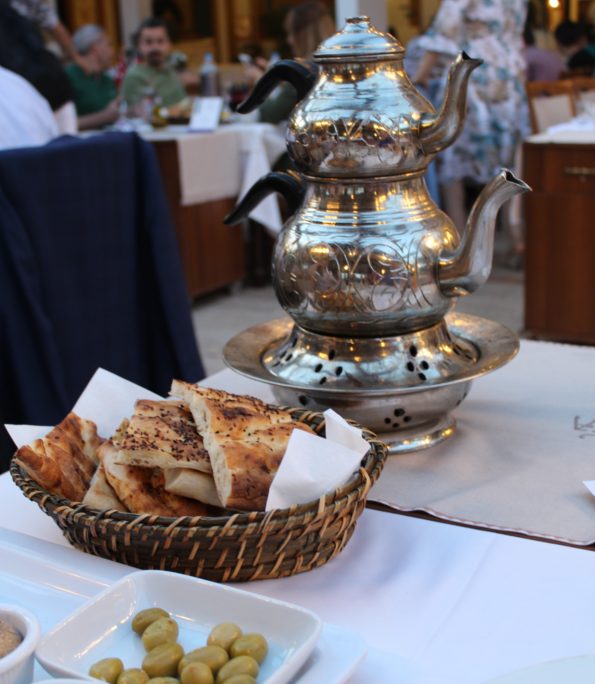 Despite the diligent fasting carried out by so many during Ramadan, the Islamic month of fasting, it is a true paradox from a culinary stand-point as traditional recipes, feasting together and dining out are an enormous focus during the month of Ramadan as well. While fasting takes place between sunrise and sunset, for many women those hours are filled with preparing delectable dishes to be enjoyed as soon as the sun goes down. This meal, which is used to break the fast each day, is called iftar (eef-tahr). This is no simple meal to just break a fast. İftar is a well-planned feast which includes traditional foods served over several courses. İftar provides a time for family members and friends to gather together for fellowship while enjoying foods that remind them of their important roots. Often relatives and groups of friends will gather together in a home or at a special restaurant to break the fast and enjoy iftar together over a course of several hours. İftar is a special time together and not meant to be rushed.
Despite the diligent fasting carried out by so many during Ramadan, the Islamic month of fasting, it is a true paradox from a culinary stand-point as traditional recipes, feasting together and dining out are an enormous focus during the month of Ramadan as well. While fasting takes place between sunrise and sunset, for many women those hours are filled with preparing delectable dishes to be enjoyed as soon as the sun goes down. This meal, which is used to break the fast each day, is called iftar (eef-tahr). This is no simple meal to just break a fast. İftar is a well-planned feast which includes traditional foods served over several courses. İftar provides a time for family members and friends to gather together for fellowship while enjoying foods that remind them of their important roots. Often relatives and groups of friends will gather together in a home or at a special restaurant to break the fast and enjoy iftar together over a course of several hours. İftar is a special time together and not meant to be rushed.
 Last year I had the privilege of attending an iftar meal at Vesta restaurant in Istanbul. It really is an amazing experience from before it even starts to the finish! My friends and I arrived more than an hour early so got to witness the frenzied rush to prepare everything. We were ushered to our table which was already draped with a pristine white cloth and laden with a variety of appetizers and drinks. In the center was a large platter containing little dishes of black and green olives, a variety of white cheeses, homemade jams, honey and dried nuts and fruit like walnuts, figs, apricots and dates. There was also a myriad of side dishes like the yogurt-based Semizotu Salad, spicy tomato salsa, Carrot Salad, Haydari and Hummus. And of course, a massive basket of bread and fresh-from-the-oven pide!
Last year I had the privilege of attending an iftar meal at Vesta restaurant in Istanbul. It really is an amazing experience from before it even starts to the finish! My friends and I arrived more than an hour early so got to witness the frenzied rush to prepare everything. We were ushered to our table which was already draped with a pristine white cloth and laden with a variety of appetizers and drinks. In the center was a large platter containing little dishes of black and green olives, a variety of white cheeses, homemade jams, honey and dried nuts and fruit like walnuts, figs, apricots and dates. There was also a myriad of side dishes like the yogurt-based Semizotu Salad, spicy tomato salsa, Carrot Salad, Haydari and Hummus. And of course, a massive basket of bread and fresh-from-the-oven pide!
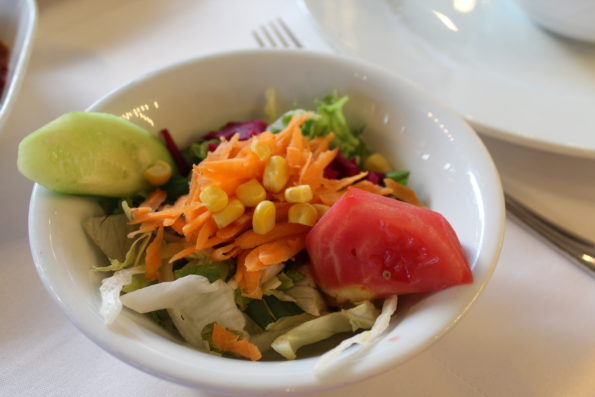 There was a plethora of drinks from which to choose and several glasses at each place. Since those diligently fasting during Ramadan refrain from drinking as well as eating during all daylight hours, this is an important time to replenish fluids. Typical choices included: water, cola, orange fanta, Ayran (a yogurt chiller), iced tea, and of course each table had it’s own little charcoal burner with a pot of black tea: çay as we say in Turkish.
There was a plethora of drinks from which to choose and several glasses at each place. Since those diligently fasting during Ramadan refrain from drinking as well as eating during all daylight hours, this is an important time to replenish fluids. Typical choices included: water, cola, orange fanta, Ayran (a yogurt chiller), iced tea, and of course each table had it’s own little charcoal burner with a pot of black tea: çay as we say in Turkish.
As we sat at our table and watched the waiters scurry around preparing everything to be perfect for the guests’ arrival, we realized again just how important appearances are in Turkey. The presentation of everything was pristine and garnished perfectly. A small bowl of fresh salad was placed in front of each place along with a bottle of olive oil and pomegranate syrup which could be used as a dressing.
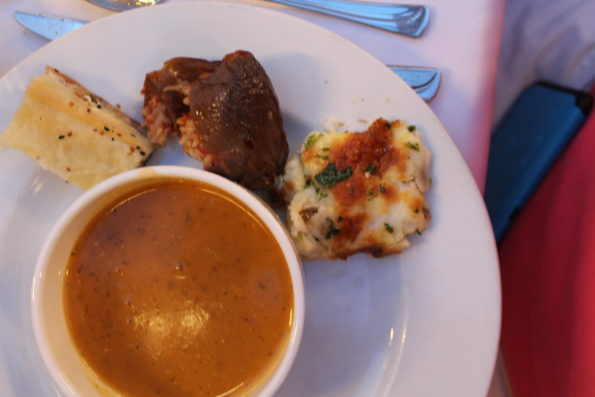 Guests began trickling in and the excitement and anticipation grew to a palpable level. It was fun to watch relatives and friends greet each other and begin animated conversations. Additional dishes were brought out and placed on each table which included Mantı (Turkish ravioli in a yogurt sauce), Dolma (stuffed peppers, eggplants and squash) and Börek to name just a few. At the same time each pair of servers brought out a large soup tureen and began ladling Red Lentil Soup or Ezogelin Soup into individual bowls which were also placed in front of each guest. By this point the tables were laden with an abundance of amazing dishes, and the smells alone had everyone checking their watch and counting down the minutes until we could begin.
Guests began trickling in and the excitement and anticipation grew to a palpable level. It was fun to watch relatives and friends greet each other and begin animated conversations. Additional dishes were brought out and placed on each table which included Mantı (Turkish ravioli in a yogurt sauce), Dolma (stuffed peppers, eggplants and squash) and Börek to name just a few. At the same time each pair of servers brought out a large soup tureen and began ladling Red Lentil Soup or Ezogelin Soup into individual bowls which were also placed in front of each guest. By this point the tables were laden with an abundance of amazing dishes, and the smells alone had everyone checking their watch and counting down the minutes until we could begin.
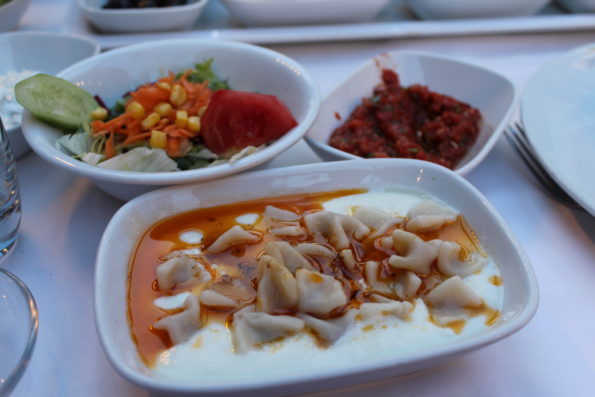 As soon as the call to prayer could be heard from the nearby mosques, everyone took a sip of water and dug into the food. Most people start with a few dates and simple things from the large platter on the center of each table before anxiously digging into their fragrant bowl of soup. And of course, everything is eaten with lots and lots of bread. Pretty soon the din rose to an almost unbearable level as the feasting began in earnest and the sound of silverware scraping against porcelain could be heard from each place above the laughter and chatting.
As soon as the call to prayer could be heard from the nearby mosques, everyone took a sip of water and dug into the food. Most people start with a few dates and simple things from the large platter on the center of each table before anxiously digging into their fragrant bowl of soup. And of course, everything is eaten with lots and lots of bread. Pretty soon the din rose to an almost unbearable level as the feasting began in earnest and the sound of silverware scraping against porcelain could be heard from each place above the laughter and chatting.
As soon as these first courses were done, many of the guests walked outside to smoke while the waiters cleared the empty dishes and served the main course. To be honest, by this time I was satisfactorily full and felt like I had eaten a delicious feast already! Alas, large plates arrived at each place filled with freshly shaved Döner Meat, Rice Pilaf, Karnıyarık, and so much more. Honestly, at this point I stopped taking notes and just tried to find a bit more room to squeeze all of this delicious food in. As my eyes began to glaze over due to the amazing amount of food I had just enjoyed, I noticed that they began bringing out the next course and serving the çay in earnest. Platters of Baklava were brought to each table. I thought that would be a nice and sweet way to end the meal, but the end was not in sight yet. The Baklava and tea were to be enjoyed while each table waited its turn to walk over to the massive dessert buffet and fill their own plate from the myriad of desserts offered. Everything from the sweet and dripping Revani Cake and Milk Syrup Cake, to small hand-rolled Un Helvası topped with nuts, to parfait glasses with Chocolate Pudding or traditional clay ones filled with Rice Pudding, to specially garnished Sweet Custard to name just a few. Of course the main attraction was Güllaç, which is a very special dessert served only during the month of Ramadan. This was my first time to eat it and I haven’t yet learned to make it, but hope to soon. It’s a very wet dessert soaked in sweetened milk and topped with nuts and pomegranate seeds.
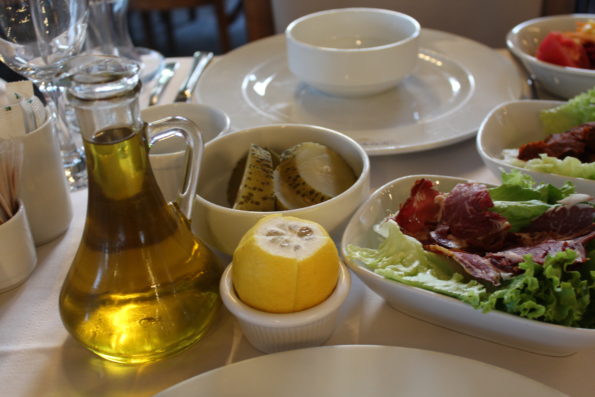 As if we had an ounce of room left in our stomachs, the waiters then brought out large platters laden with fresh cut fruit. They also served each guest a small cup of rich Turkish Coffee with a piece of Turkish Delight. The feasting and merrymaking looked to continue for a few hours yet, but my friends and I left early and enjoyed a long walk along the seaside to try and walk off a tiny bit of all that we had just enjoyed.
As if we had an ounce of room left in our stomachs, the waiters then brought out large platters laden with fresh cut fruit. They also served each guest a small cup of rich Turkish Coffee with a piece of Turkish Delight. The feasting and merrymaking looked to continue for a few hours yet, but my friends and I left early and enjoyed a long walk along the seaside to try and walk off a tiny bit of all that we had just enjoyed.
Experiencing this iftar first-hand was such a treasured experience that I can remember it in vivid details even 9 months later as I finally sit down to write about the experience. It also included all of the important pieces that I’ve heard are held dear during iftar traditions. Following the example of the prophet Muhammad who sipped water and ate 3 dates to break his fast, this is how almost all of the guests began. Next a variety of appetizers and lentil soup were enjoyed, before a main meal consisting of a variety of meat and vegetables with rice. The seemingly unending assortment of desserts and tea comes next, topped off by fresh fruit and Turkish coffee. While each family and town has its own variety of important traditions, these are the common traditions which bind Turks together during the month of Ramadan. Many markets have special Ramadan displays during the entire month and they always include dates, dried fruit and nuts, Güllaç pastry-dough, and boxes of Turkish Delight alongside huge bags of black tea leaves. İftar is not a meal one simply sits down to casually. Preparing the iftar table is a true art form which can confound even the best of chefs abroad. From the pristine place settings to the plethora of food which is served, it is an experience of the finest quality and truly amazing that Turkish women can prepare and serve such a feast so many times in one month.



Deb
Amazing story! So glad you had the chance to experience this special time & share your wonderful memories w/ us!
Amber
I can just hear your voice telling the whole story ❤️ You were so well!